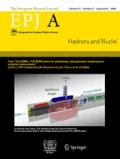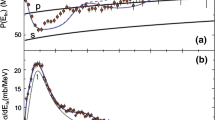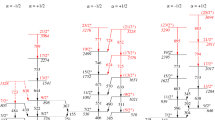Abstract.
The 110,112 Rh and 114,116 Ag nuclei have been produced as fission fragments in the fusion reaction 18 O+208 Pb at 85 MeV. Their level schemes have been built from gamma-rays detected using the Euroball IV array. High-spin states of these neutron-rich nuclei have been identified for the first time. The yrast structures consist of rotational bands in which the odd proton occupies the \(\pi g_{9/2}\) sub-shell and the odd neutron the \(\nu h_{11/2}\) sub-shell. The evolution of the \(\pi g_{9/2} \otimes \nu h_{11/2}\) band structure is analyzed as a function of the neutron number.
Similar content being viewed by others
References
M.-G. Porquet et al., Eur. Phys. J. A 15, 463 (2002).
I. Hamamoto, Phys. Lett. B 235, 221 (1990).
J. Doring, D. Ulrich, G.D. Johns, M.A. Riley, S.L. Tabor, Phys. Rev. C 59, 71 (1999) and references therein.
J.F. Smith et al., Phys. Lett. B 406, 7 (1997) and references therein.
Y. Liu et al., Phys. Rev. C 52, 2514 (1995) and references therein.
R. Bengtsson, H. Frisk, F.R. May, J.A. Pinston, Nucl. Phys. A 415, 189 (1984).
A.K. Jain, A. Goel, Phys. Lett. B 277, 233 (1992).
P.B. Semmes, I. Ragnarsson, International Conference on High Spin Physics and Gamma-Soft Nuclei, Pittsburgh, September 1990 (World Scientific, Singapore, 1991) p. 500.
J. Simpson, Z. Phys. A 358, 139 (1997).
I. Deloncle, M.-G. Porquet, M. Dziri-Marcé, Nucl. Instrum. Methods A 357, 150 (1995).
D. Radford, Nucl. Instrum. Methods A 361, 297
M.A.C. Hotchkis et al., Nucl. Phys. A 530, 111 (1991).
M.G. Porquet et al., Acta Phys. Polon. B 27, 179 (1996).
R. Lucas et al., Eur. Phys. J. A 15, 315 (2002).
Ts. Venkova et al., Eur. Phys. J. A 15, 429 (2002).
Ts. Venkova et al., Eur. Phys. J. A 6, 405 (1999).
R.B. Firestone, Table of Isotopes, 8th edition (Wiley, New York, 1996).
G. Lhersonneau et al., Phys. Rev. C 60, 014315 (1999).
J.K. Hwang et al., Phys. Rev. C 57, 2250 (1998).
F.R. Espinoza-Quiñones et al., Phys. Rev. C 52, 104 (1995).
R. Popli, F.A. Rickey, L.E. Samuelson, P.C. Simms, Phys. Rev. C 23, 1085 (1981).
M.-G. Porquet et al., Proton orbitals and rotational structures in the neutron rich \(^{111 -117}Ag\) isotopes, in preparation.
J.K. Hwang et al., Phys Rev. C 65, 054314 (2002).
A.M. Bizzeti-Sona et al., Z. Phys. A 335, 365 (1990).
J. Blachot, Nucl. Data Sheets 97, 597 (2002).
N. Buforn, Eur. Phys. J. A 7, 347 (2000).
M. Houry et al., Eur. Phys. J. A 6, 43 (1999).
R. Krücken et al., Phys. Rev. C 60, 031302 (1999).
X.Q. Zhang et al., Phys. Rev. C 61, 014305 (1999).
M.-G. Porquet et al., Evolution of the \(\pi g_{9/2} -(\nu h_{11/2})^2\) multiplet in the neutron rich \(^{49}In\) isotopes: Evidence of the gradual filling of a sub-shell, to be submitted to Eur. Phys. J. A.
Author information
Authors and Affiliations
Corresponding author
Additional information
Communicated by D. Schwalm
Received: 20 March 2003, Revised: 8 May 2003, Published online: 23 September 2003
PACS:
21.60.Ev Collective models - 23.20.Lv \(\gamma\) transitions and level energies - 25.85.Ge Charged-particle-induced fission - 27.60.+j \(90\leq A\leq 149\)
A. Astier: Present address: CSNSM, IN2P3-CNRS and Université Paris-Sud, 91405 Orsay, France.
L. Donadille: Present address: CEA/Saclay, DSM/DAPNIA/SPhN, 91191 Gif-sur-Yvette Cedex, France.
Rights and permissions
About this article
Cite this article
Porquet, MG., Venkova, T., Astier, A. et al. Evolution of the \(\pi g_{9/2} \otimes \nu h_{11/2}\) configuration in the neutron-rich \(^{110,112}_{\quad\ \; 45}Rh\) and \(^{114,116}_{\quad\ \; 47}Ag\) isotopes. Eur. Phys. J. A 18, 25–30 (2003). https://doi.org/10.1140/epja/i2003-10062-x
Issue Date:
DOI: https://doi.org/10.1140/epja/i2003-10062-x




